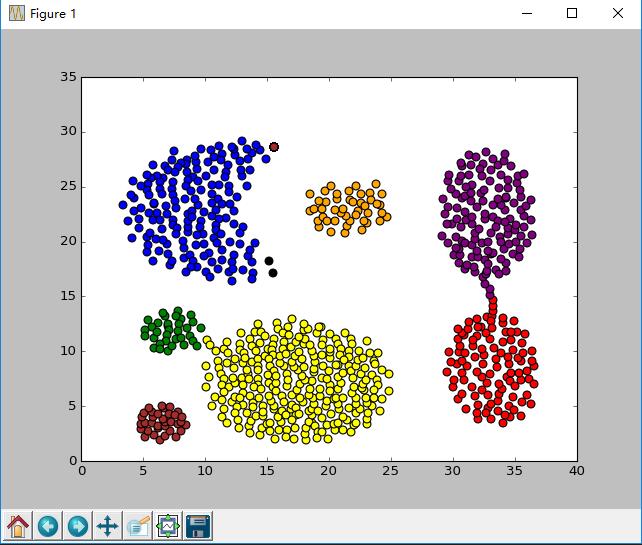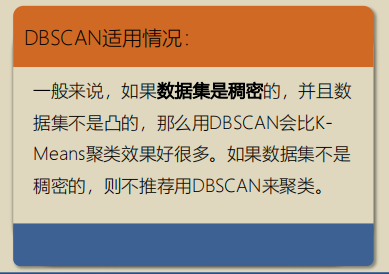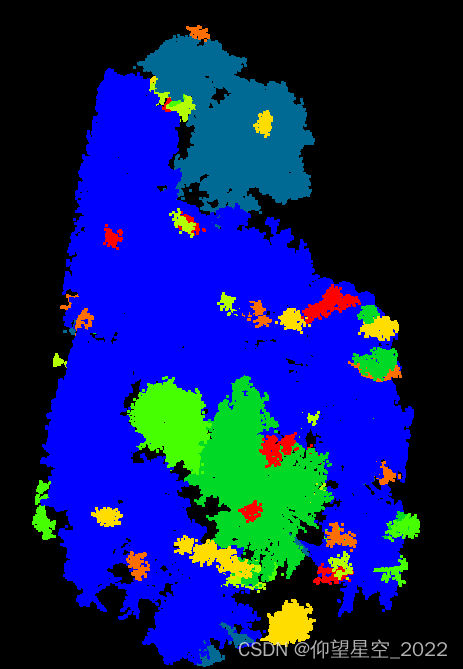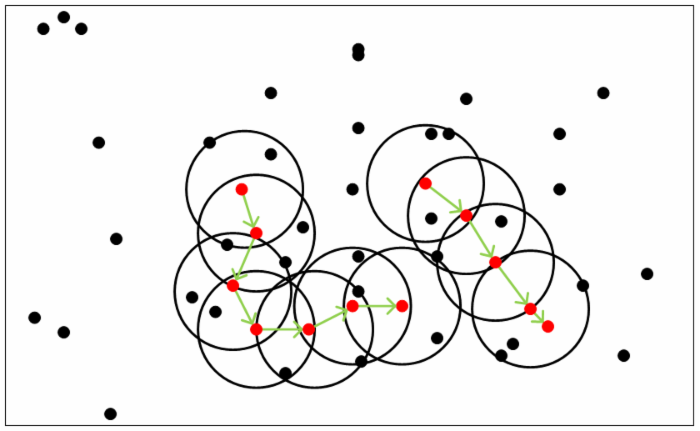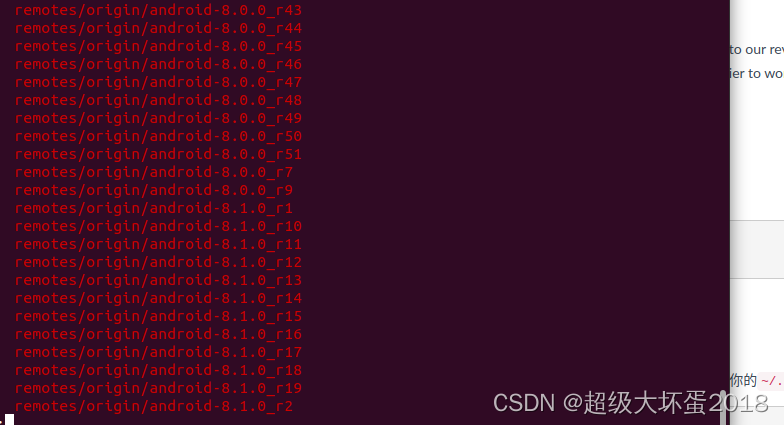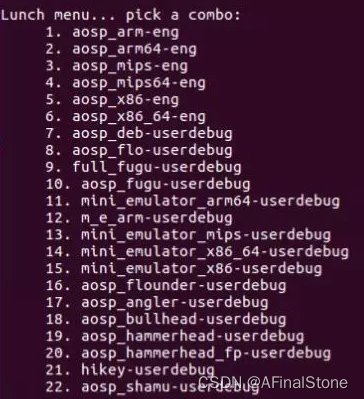最近由于要实现‘基于网格的DBSCAN算法’,网上有没有找到现成的代码[如果您有代码,麻烦联系我],只好参考已有的DBSCAN算法的实现。先从网上随便找了几篇放这儿,之后对比研究。
DBSCAN简介:
1.简介
DBSCAN 算法是一种基于密度的空间聚类算法。该算法利用基于密度的聚类的概念,即要求聚类空间中的一定区域内所包含对象(点或其它空间对象)的数目不小于某一给定阀 值。DBSCAN 算法的显著优点是聚类速度快且能够有效处理噪声点和发现任意形状的空间聚类。但是由于它直接对整个数据库进行操作且进行聚类时使用了一个全局性的表征 密度的参数,因此也具有两个比较明显的弱点:
1. 当数据量增大时,要求较大的内存支持 I/0 消耗也很大;
2. 当空间聚类的密度不均匀、聚类间距离相差很大时,聚类质量较差。
2.DBSCAN算法的聚类过程
DBSCAN算法基于一个事实:一个聚类可以由其中的任何核心对象唯一确定。等价可以表述为: 任一满足核心对象条件的数据对象p,数据库D中所有从p密度可达的数据对象o 所组成的集合构成了一个完整的聚类C,且p属于C。
3.DBSCAN中的几个定义
密度可达是直接密度可达的传递闭包,非对称性关系;密度相连是对称性关系。DBSCA目的是找到密度相连对象的最大集合。
E领域:给定对象p半径为E内的区域称为该对象的E领域;
核心对象:p的E领域内样本数大于MinPts(算法输入值),则该对象p为核心对象;
直接密度可达:对于样本集合D,如果样本点q在p的E领域内,且p为核心对象,则p直接密度可达q;
密度可达:对于样本集合D,存在一串样本点p1,p2,p3,...pn,其中连续两个点直接密度可达,则 p=p1,q=qn,则p密度可达q;
密度相连:对于样本集合D中任意一点o,存在p到o密度可达,并且q到o密度可达,那么q从p密度相连;
算法伪代码


1 DBSCAN(SetOfPoints, Eps, MinPts){2 ClusterId=nextId(NOISE)3 for(i=0;i
13 ExpandCluster(SetOfPoints,Point, ClId, Eps, MinPts){14 seeds=SetOfPoints.regionQuery(Point, Eps)15 if(seeds.size()0){22 currentP=seeds.first()23 result=SetOfPoints.regionQuery(currentP, Eps)24 if(result.size()>=MinPts){25 for(i=0;i
View Code
JAVA实现:


1 packageorisun;2
3 importjava.io.File;4 importjava.util.ArrayList;5 importjava.util.Vector;6 importjava.util.Iterator;7
8 public classDBScan {9
10 double Eps=3; //区域半径
11 int MinPts=4; //密度12
13 //由于自己到自己的距离是0,所以自己也是自己的neighbor
14 public Vector getNeighbors(DataObject p,ArrayListobjects){15 Vector neighbors=new Vector();16 Iterator iter=objects.iterator();17 while(iter.hasNext()){18 DataObject q=iter.next();19 double[] arr1=p.getVector();20 double[] arr2=q.getVector();21 int len=arr1.length;22
23 if(Global.calEditDist(arr1,arr2,len)<=Eps){ //使用编辑距离24 //if(Global.calEuraDist(arr1, arr2, len)<=Eps){//使用欧氏距离25 //if(Global.calCityBlockDist(arr1, arr2, len)<=Eps){//使用街区距离26 //if(Global.calSinDist(arr1, arr2, len)<=Eps){//使用向量夹角的正弦
27 neighbors.add(q);28 }29 }30 returnneighbors;31 }32
33 public int dbscan(ArrayListobjects){34 int clusterID=0;35 boolean AllVisited=false;36 while(!AllVisited){37 Iterator iter=objects.iterator();38 while(iter.hasNext()){39 DataObject p=iter.next();40 if(p.isVisited())41 continue;42 AllVisited=false;43 p.setVisited(true); //设为visited后就已经确定了它是核心点还是边界点
44 Vector neighbors=getNeighbors(p,objects);45 if(neighbors.size()
48 }else{49 if(p.getCid()<=0){50 clusterID++;51 expandCluster(p,neighbors,clusterID,objects);52 }else{53 int iid=p.getCid();54 expandCluster(p,neighbors,iid,objects);55 }56 }57 AllVisited=true;58 }59 }60 returnclusterID;61 }62
63 private void expandCluster(DataObject p, Vectorneighbors,64 int clusterID,ArrayListobjects) {65 p.setCid(clusterID);66 Iterator iter=neighbors.iterator();67 while(iter.hasNext()){68 DataObject q=iter.next();69 if(!q.isVisited()){70 q.setVisited(true);71 Vector qneighbors=getNeighbors(q,objects);72 if(qneighbors.size()>=MinPts){73 Iterator it=qneighbors.iterator();74 while(it.hasNext()){75 DataObject no=it.next();76 if(no.getCid()<=0)77 no.setCid(clusterID);78 }79 }80 }81 if(q.getCid()<=0){ //q不是任何簇的成员
82 q.setCid(clusterID);83 }84 }85 }86
87 public static voidmain(String[] args){88 DataSource datasource=newDataSource();89 //Eps=3,MinPts=4
90 datasource.readMatrix(new File("/home/orisun/test/dot.mat"));91 datasource.readRLabel(new File("/home/orisun/test/dot.rlabel"));92 //Eps=2.5,MinPts=493 //datasource.readMatrix(new File("/home/orisun/text.normalized.mat"));94 //datasource.readRLabel(new File("/home/orisun/text.rlabel"));
95 DBScan ds=newDBScan();96 int clunum=ds.dbscan(datasource.objects);97 datasource.printResult(datasource.objects,clunum);98 }99 }
View Code
C++实现:
数据结构


1 #include
2
3 using namespacestd;4
5 const int DIME_NUM=2; //数据维度为2,全局常量6
7 //数据点类型
8 classDataPoint9 {10 private:11 unsigned long dpID; //数据点ID
12 double dimension[DIME_NUM]; //维度数据
13 long clusterId; //所属聚类ID
14 bool isKey; //是否核心对象
15 bool visited; //是否已访问
16 vector arrivalPoints; //领域数据点id列表
17 public:18 DataPoint(); //默认构造函数
19 DataPoint(unsigned long dpID,double* dimension , bool isKey); //构造函数
20
21 unsigned long GetDpId(); //GetDpId方法
22 void SetDpId(unsigned long dpID); //SetDpId方法
23 double* GetDimension(); //GetDimension方法
24 void SetDimension(double* dimension); //SetDimension方法
25 bool IsKey(); //GetIsKey方法
26 void SetKey(bool isKey); //SetKey方法
27 bool isVisited(); //GetIsVisited方法
28 void SetVisited(bool visited); //SetIsVisited方法
29 long GetClusterId(); //GetClusterId方法
30 void SetClusterId(long classId); //SetClusterId方法
31 vector& GetArrivalPoints(); //GetArrivalPoints方法
32 };
View Code
实现


1 #include "DataPoint.h"
2
3 //默认构造函数
4 DataPoint::DataPoint()5 {6 }7
8 //构造函数
9 DataPoint::DataPoint(unsigned long dpID,double* dimension , boolisKey):isKey(isKey),dpID(dpID)10 {11 //传递每维的维度数据
12 for(int i=0; idimension[i]=dimension[i];15 }16 }17
18 //设置维度数据
19 void DataPoint::SetDimension(double*dimension)20 {21 for(int i=0; idimension[i]=dimension[i];24 }25 }26
27 //获取维度数据
28 double*DataPoint::GetDimension()29 {30 return this->dimension;31 }32
33 //获取是否为核心对象
34 boolDataPoint::IsKey()35 {36 return this->isKey;37 }38
39 //设置核心对象标志
40 void DataPoint::SetKey(boolisKey)41 {42 this->isKey =isKey;43 }44
45 //获取DpId方法
46 unsigned longDataPoint::GetDpId()47 {48 return this->dpID;49 }50
51 //设置DpId方法
52 void DataPoint::SetDpId(unsigned longdpID)53 {54 this->dpID =dpID;55 }56
57 //GetIsVisited方法
58 boolDataPoint::isVisited()59 {60 return this->visited;61 }62
63
64 //SetIsVisited方法
65 void DataPoint::SetVisited( boolvisited )66 {67 this->visited =visited;68 }69
70 //GetClusterId方法
71 longDataPoint::GetClusterId()72 {73 return this->clusterId;74 }75
76 //GetClusterId方法
77 void DataPoint::SetClusterId( longclusterId )78 {79 this->clusterId =clusterId;80 }81
82 //GetArrivalPoints方法
83 vector&DataPoint::GetArrivalPoints()84 {85 returnarrivalPoints;86 }
View Code
PYTHON实现:


1 from matplotlib.pyplot import *
2 fromcollections import defaultdict3 import random4
5 #function to calculate distance6 def dist(p1, p2):7 return ((p1[0]-p2[0])**2+ (p1[1]-p2[1])**2)**(0.5)8
9 #randomly generate around 100cartesian coordinates10 all_points=[]11
12 for i in range(100):13 randCoord = [random.randint(1,50), random.randint(1,50)]14 if not randCoord inall_points:15 all_points.append(randCoord)16
17
18 #take radius = 8 and min. points = 8
19 E = 8
20 minPts = 8
21
22 #find outthe core points23 other_points =[]24 core_points=[]25 plotted_points=[]26 for point inall_points:27 point.append(0) # assign initial level 0
28 total = 0
29 for otherPoint inall_points:30 distance =dist(otherPoint,point)31 if distance<=E:32 total+=1
33
34 if total >minPts:35 core_points.append(point)36 plotted_points.append(point)37 else:38 other_points.append(point)39
40 #find border points41 border_points=[]42 for core incore_points:43 for other inother_points:44 if dist(core,other)<=E:45 border_points.append(other)46 plotted_points.append(other)47
48
49 #implement the algorithm50 cluster_label=0
51
52 for point incore_points:53 if point[2]==0:54 cluster_label+=1
55 point[2]=cluster_label56
57 for point2 inplotted_points:58 distance =dist(point2,point)59 if point2[2] ==0 and distance<=E:60 print point, point261 point2[2] =point[2]62
63
64 #after the points are asssigned correnponding labels, we group them65 cluster_list =defaultdict(lambda: [[],[]])66 for point inplotted_points:67 cluster_list[point[2]][0].append(point[0])68 cluster_list[point[2]][1].append(point[1])69
70 markers = ['+','*','.','d','^','v','>','
72 #plotting the clusters73 i=0
74 print cluster_list75 for value incluster_list:76 cluster=cluster_list[value]77 plot(cluster[0], cluster[1],markers[i])78 i = i%10+1
79
80 #plot the noise points aswell81 noise_points=[]82 for point inall_points:83 if not point in core_points and not point inborder_points:84 noise_points.append(point)85 noisex=[]86 noisey=[]87 for point innoise_points:88 noisex.append(point[0])89 noisey.append(point[1])90 plot(noisex, noisey, "x")91
92 title(str(len(cluster_list))+"clusters created with E ="+str(E)+"Min Points="+str(minPts)+"total points="+str(len(all_points))+"noise Points ="+str(len(noise_points)))93 axis((0,60,0,60))94 show()
View Code
参考:http://www.cnblogs.com/zhangchaoyang/articles/2182748.html
http://www.cnblogs.com/lovell-liu/archive/2011/11/08/2241542.html
http://blog.sudipk.com.np/2013/02/implementation-of-dbscan-algorithm-for.html
http://caoyaqiang.diandian.com/post/2012-09-26/40039517485
